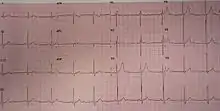Benign early repolarization
Benign early repolarization also known as early repolarization (abbr.: BER) is found on ECG in about 1% of those with chest pain.[1] It is diagnosed based on an elevated J-point / ST elevation where the ST segment is concave up. It is believed to be a normal variant.[1]

Benign early repolarization that occurs in the inferior and lateral portion of the heart muscle is associated with ventricular fibrillation. The association, revealed by research performed in the late 2000s, is small.
Associations with serious conditions
Research in the late 2000s has linked this finding when found in the inferior and lateral ECG leads to ventricular fibrillation particularly in those who have fainted or have a family history of sudden cardiac death.[2] Studies have shown a significant relationship between ventricular fibrillation and early repolarization.[3][4] Although there is a significant relationship between ventricular fibrillation and early repolarization the overall lifetime occurrence of idiopathic ventricular fibrilation is exceptionally rare.[5] There has also been an associatation between early repolarization and short QT syndrome.[6]
Electrocardiography
On an electrocardiogram (EKG or ECG), benign early repolarization may produce an elevation of the ST segment, similar to that observed in heart attacks (myocardial infarction). However, with benign early repolarization, the ST segment is usually concave up, rather than concave down (as with heart attacks), and there is a notable absence of reciprocal changes suggestive of ischemia on the EKG.
Epidemiology
Benign early repolarization occurs in about 1 to 13 percent of the general population with a significant increase in occurrence within athletes and adolescents.[7] In one study, an occurrence of early repolarization was observed in 31.6% of elite athletes while in another study occurrence was observed in 25.1% of athletes.[8][9]
References
- Brady WJ, Chan TC (1999). "Electrocardiographic manifestations: benign early repolarization". The Journal of Emergency Medicine. 17 (3): 473–8. doi:10.1016/S0736-4679(99)00010-4. PMID 10338242.
- Stern S (April 2011). "Clinical aspects of the early repolarization syndrome: a 2011 update". Annals of Noninvasive Electrocardiology. 16 (2): 192–5. doi:10.1111/j.1542-474X.2011.00429.x. PMC 6932469. PMID 21496171.
- Haïssaguerre M, Derval N, Sacher F, Jesel L, Deisenhofer I, de Roy L, et al. (May 2008). "Sudden cardiac arrest associated with early repolarization". The New England Journal of Medicine. 358 (19): 2016–23. doi:10.1056/NEJMoa071968. PMID 18463377.
- Nam GB, Kim YH, Antzelevitch C (May 2008). "Augmentation of J waves and electrical storms in patients with early repolarization". The New England Journal of Medicine. 358 (19): 2078–9. doi:10.1056/NEJMc0708182. PMC 2515862. PMID 18463391.
- Priori SG, Wilde AA, Horie M, Cho Y, Behr ER, Berul C, et al. (October 2013). "Executive summary: HRS/EHRA/APHRS expert consensus statement on the diagnosis and management of patients with inherited primary arrhythmia syndromes". Europace. 15 (10): 1389–406. doi:10.1093/europace/eut272. PMID 23994779.
- Watanabe H, Makiyama T, Koyama T, Kannankeril PJ, Seto S, Okamura K, et al. (May 2010). "High prevalence of early repolarization in short QT syndrome". Heart Rhythm. 7 (5): 647–52. doi:10.1016/j.hrthm.2010.01.012. PMID 20206319.
- Bourier F, Denis A, Cheniti G, Lam A, Vlachos K, Takigawa M, et al. (2018-11-27). "Early Repolarization Syndrome: Diagnostic and Therapeutic Approach". Frontiers in Cardiovascular Medicine. 5: 169. doi:10.3389/fcvm.2018.00169. PMC 6278243. PMID 30542653.
- Serra-Grima R, Doñate M, Álvarez-García J, Barradas-Pires A, Ferrero A, Carballeira L, et al. (February 2015). "Long-term follow-up of early repolarization pattern in elite athletes". The American Journal of Medicine. 128 (2): 192.e1-9. doi:10.1016/j.amjmed.2014.06.017. PMID 24979742.
- Noseworthy PA, Weiner R, Kim J, Keelara V, Wang F, Berkstresser B, et al. (August 2011). "Early repolarization pattern in competitive athletes: clinical correlates and the effects of exercise training". Circulation: Arrhythmia and Electrophysiology. 4 (4): 432–40. doi:10.1161/CIRCEP.111.962852. PMC 3700366. PMID 21543642.